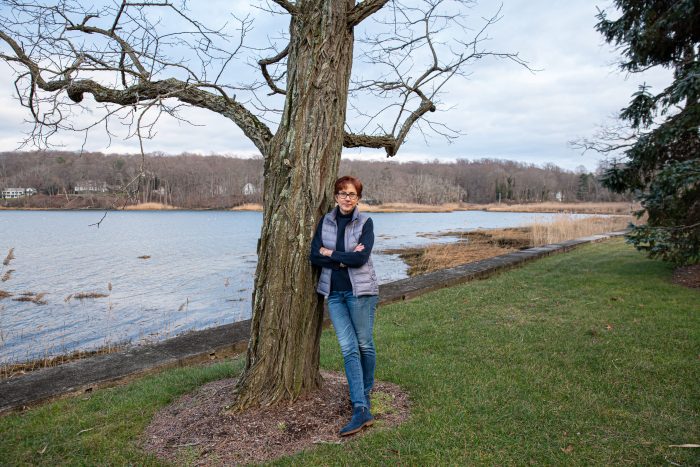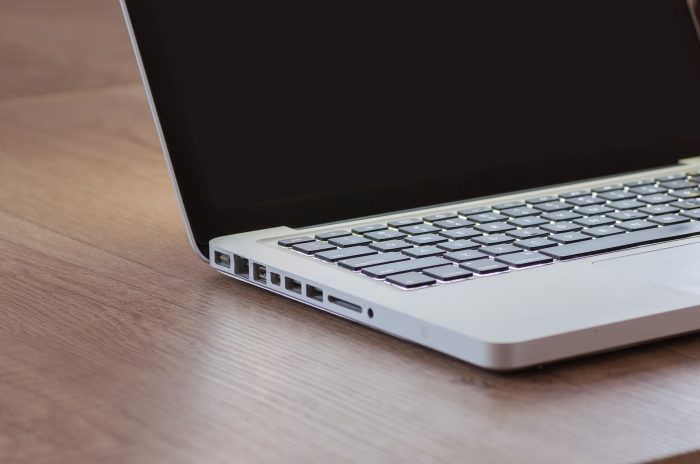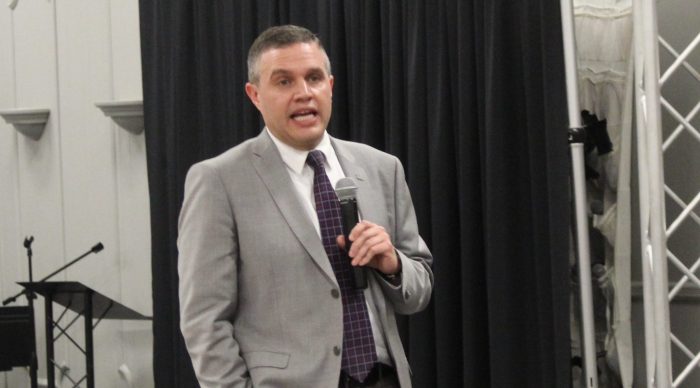Rallying against a proposed private dock has given one Head of the Harbor resident inspiration to run for village trustee.

Last year, Lisa Davidson and her neighbors were busy fighting the proposed construction of an 186-foot private dock on Swan Place in Nissequogue, which, if approved, would have been right next to Cordwood Park and Head of the Harbor.
Now, Davidson aims to collect 51 signatures by Feb. 14 to run for trustee in March. Two trustee seats will be open during the March 21 election as Daniel White and Jeff Fischer are up for reelection.
Not one to sit on the sidelines, Davidson said, “Just complaining accomplishes nothing.”
A village resident for more than two years, she immediately fell in love with Head of the Harbor. During her short time living on Long Island, Davidson said she has been a representative on the village’s Joint Village Coastal Management Commission, a Suffolk County polling inspector and a volunteer with Island Harvest food bank.
The wife and mother, who recently became a grandmother, was born in Los Angeles, and raised her two sons in New York City. An alum of UCLA, her professional career includes working as a business reporter with the Los Angeles Times and a field producer with Fox News. She has also worked for the National Geographic Society. Currently she is a consultant for those looking to produce their own television projects.
She said in addition to living in places such as California and New York City, her work as a print journalist, news and television producer took her around the world, which Davidson said has given her even more appreciation for her current hometown. She added Stony Brook Harbor, the village’s “tree-lined streets, and the views from Cordwood Park rival them all.”
The trustee-hopeful explained her run all comes down to preserving the rustic charm of Head of the Harbor.
“It’s human nature when you’re exposed to something of beauty, you take it for granted instead of realizing, ‘Wow, this is so special,’” she said.
Last year her love for the village inspired her to help gather signatures for a petition, organize a rally at Cordwood Park and attend Nissequogue Village Planning Board meetings multiple times to speak out when the private dock on Swan Place was proposed. The board denied the owner’s request at the beginning of this year.
She and others collected 787 signatures on the petition to oppose the structure.
“It was really clear that the community did not want that dock,” she said.
An Aug. 27 rally at Cordwood Park, organized by Davidson, drew environmentalists such as former state Assemblyman Steve Englebright (D-Setauket); Kevin McAllister, founder and president of Defend H2O; and John Turner, conservation chair of Four Harbors Audubon Society.
Ralliers listed issues with private docks in the area, such as the shallowness of the water in the area. The Department of Environmental Conservation requires docks stand in 3 1/2 feet of water even at low tide. The length of the proposed Swan Place dock would have obstructed residents’ view of Stony Brook Harbor and restrict access to those walking along the beach or using their kayaks and canoes in the water. A dock would also adversely affect birds, turtles, flora and fauna as well as the water quality.
Another concern of Davidson and others was that if the village allowed one to be built, others would follow.
“If that one dock would have been allowed, he’d be representing every single person on this harbor, who wanted a dock demanding that, ‘Well, you let that one in, you have to let this other one,’” she said.
According to Davidson, another issue is that while an owner may own their land, they do not own the water. If a dock were allowed, she said, it would be the private taking of public land.
“If it was somewhere else on the harbor, it wouldn’t have been so catastrophic to the community,” she said. “That dock was going to take public land that was used all the time and make it private.”
“Let’s figure out how this can work for everybody, and that’s what I would like to do in general.”
— Lisa Davidson
Davidson said it’s vital for the villages to follow the Local Water Revitalization Program when making decisions regarding coastal management, something she said some seem to have forgotten.
She added that another one of her concerns is the budget as the village has started to spend its reserve, and she would like to see more transparency in the village, as she believes many residents don’t know the trustees’ decisions before they finalize them. Davidson said updating the village’s website and the return of the newsletter would help the trustees communicate better.
Many residents have also asked for the Hitherbrook Road extension, where kayaks were once launched, to be restored for use. Currently there are boulders there, because in the past a few drivers were known to have driven down the dirt road and wind upin the harbor at low tide and thenbe stuck. She said there has to be a solution to allow people to use their kayaks there once again but also be safe.
“There’s no listening,” she said. “Let’s figure out how this can work for everybody, and that’s what I would like to do in general.”
Like many in the village, Davidson has also been keeping an eye on the Gyrodyne property on Route 25A, right outside of the village, and its possible development in the future. In the past, the owners have talked about the possibility of developers constructing a hotel and assisted living facility. She said, “The village and its residents have made it really clear — they want to preserve our historic corridor and open spaces because once we allow development we’ve lost those assets forever.”
Davidson added she supports Head of the Harbor Mayor Douglas Dahlgard’s plea to preserve the entire property as a park.
“Short of that, the compromise plan, whereby half remains as open space and half is developed, is acceptable to the community,” she said. “Unfortunately, we now have another threat to that area as Albany is seeking land on which to build affordable housing. Whether it’s housing or a hotel, the streets cannot handle the additional traffic those would bring so we have a real challenge ahead of us.”















